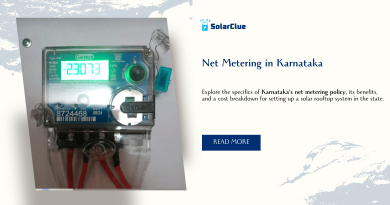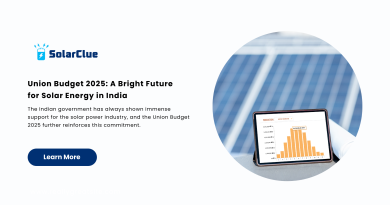Solar Power Installation Cost: Unveiling Home Plant Expenses
Solar power is a rapidly growing source of renewable energy that has the potential to revolutionize the way we generate electricity. Harnessing the power of the sun, solar panels convert sunlight into usable energy. This clean and sustainable technology offers numerous environmental and economic benefits, making it an attractive option for individuals, businesses, and governments across the globe. In this blog, we will break down the intricate process of how solar power works, from the initial absorption of sunlight to the conversion of photons into electrical energy. Gain a comprehensive understanding of this exciting field as we delve into the details of solar energy generation.
Table of Contents
The Basics of Solar Energy
At its core, solar power works by capturing the sun’s energy and converting it into electricity through a photovoltaic (PV) process. It all starts with sunlight, which contains tiny packets of energy called photons. These photons are absorbed by specialized materials, typically silicon-based solar cells, that make up the solar panels. The process of converting sunlight into electricity relies on the unique properties of these solar cells.
The Photovoltaic Effect
The heart of solar power lies in the photovoltaic effect, which is a phenomenon that occurs within the solar cells. Each solar cell is made up of one or more layers of crystalline silicon, with atoms arranged in a precise and consistent manner. When photons from sunlight strike the solar cell, they transfer their energy to electrons in the silicon atoms. This energy excites the electrons, causing them to break free from their atomic bonds and create an electron-hole pair.
The Functioning of Solar Cells
The electron-hole pairs generated within the solar cells are what drive the production of electricity. The silicon material utilized in solar cells contains positively charged regions and negatively charged regions, forming a built-in electric field. Due to this electric field, the free electrons are forced to move in one direction while the positively charged holes move in the opposite direction. This creates a flow of electric current within the solar cell.
Conversion of DC to AC
The electricity produced by solar panels is in the form of direct current (DC), a type of electrical flow that moves in a single direction. However, most of our electrical appliances and the power grid itself operate on alternating current (AC). To make solar electricity compatible with these systems, an inverter is utilized to convert DC into AC. The inverter converts the DC electricity generated by solar panels into AC electricity that can be used to power homes, businesses, and other electrical devices.
Net Metering and Integration with the Grid
One of the key advantages of solar power is its ability to integrate seamlessly with the existing electrical grid. Net metering, a billing arrangement provided by utilities, allows solar panel owners to receive credit for any excess electricity they produce. During times of surplus generation, such as sunny days, the excess electricity flows back into the grid, and the owner’s meter runs backward, effectively crediting their account. This ensures maximum utilization of solar power while maintaining access to reliable electricity from the grid during periods of low solar energy production.
Solar Power Storage
Solar power can also be stored for later use, overcoming the intermittent nature of sunlight. Energy storage systems, such as rechargeable batteries, allow excess solar energy produced during the day to be stored and used during the night or during cloudy periods. This storage capability provides increased reliability and flexibility, making solar power a viable option even in areas with inconsistent sunlight.
Environmental and Economic Benefits
Solar power offers a multitude of benefits both environmentally and economically. Firstly, solar energy is an abundant and renewable source, effectively reducing the dependence on finite fossil fuels. By generating electricity without the combustion of fossil fuels, solar power greatly reduces greenhouse gas emissions and helps mitigate climate change. Additionally, solar energy production creates local jobs, stimulates economic growth, and reduces the overall cost of electricity for consumers.
Conclusion
Unveil the expenses of home solar installations with SolarClue® as your guide to solar installation costs. Understand the factors contributing to the overall expense, including the breakdown of installation costs in 2024. Gain insights into the average cost per watt, evaluate quotes, and explore financing options such as loans and government incentives. Learn about available incentives and rebates to reduce overall expenses and address common concerns about affordability. Discover tips on budgeting and cost-saving measures without compromising system quality. Explore the potential long-term savings associated with home solar installations and the role of energy-efficient appliances and smart technologies. Let SolarClue® assist you in evaluating quotes, choosing reputable installers, and foster a community for shared experiences and collaborative learning in your solar journey.
Frequently Asked Questions
SolarClue® helps users understand the breakdown of expenses in 2024, detailing factors that contribute to the installation cost of a solar power system for homes.
SolarClue® provides insights into the average cost per watt for solar installations, guiding users on evaluating quotes and estimating the overall expense for their home solar power plants in 2024.
SolarClue® assists users in understanding the return on investment (ROI) for home solar installations, considering factors like energy savings, incentives, and potential resale value in 2024.
SolarClue® guides users in exploring financing options for solar power installations, including loans, leases, and government incentives, helping them make informed decisions about funding their home solar plants in 2024.
SolarClue® provides information on available incentives and rebates for home solar installations, helping users take advantage of government programs and local initiatives to reduce overall expenses in 2024.
SolarClue® addresses concerns about the affordability of solar power installation, offering tips on budgeting and cost-saving measures without compromising system quality in 2024.
SolarClue® educates users on the potential long-term savings associated with home solar installations, emphasizing the importance of considering the overall economic benefits over the life of the system in 2024.
SolarClue® provides information on the role of energy-efficient appliances and smart technologies in maximizing the benefits of home solar installations, ensuring users optimize their energy usage and savings in 2024.
SolarClue® assists users in evaluating quotes from solar installers, guiding them through the selection process to choose reputable and cost-effective professionals for their home solar power plants in 2024.
SolarClue® fosters a community where users share their experiences with home solar installations, creating a platform for collaborative learning and support in 2024.




